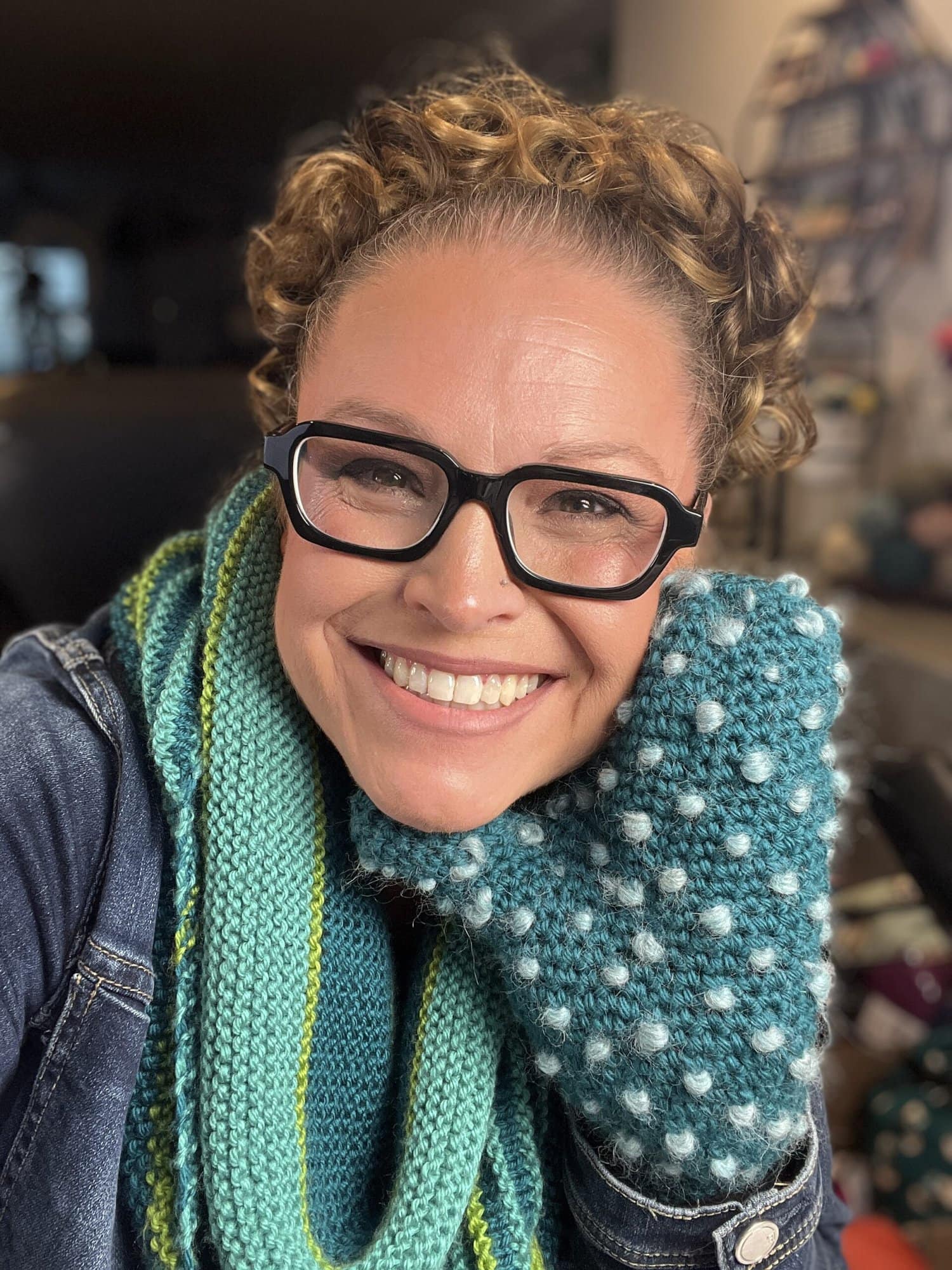What Is Knit Colorwork? Plus 65 Patterns!
When it comes to knit colorwork, you have a ton of choices. If you’re a color lover, you’ll have noticed a huge trend over the past few years of yarns with short, long, ombre, multicolor, stripe, or even knotted yarn color changes. These yarns can produce beautiful textiles, but your yarn choices are many, as are the patterns created for these yarns (some of which you’ll see farther down the page).

But what if YOU want to be the master of changing colors? What if YOU want to choose your own colors different from those chosen by the color-changing yarn designers? What options do you have to experiment and be the owner of your color choices, patterning, and resulting knitted fabric?
I’m so glad you asked! Let’s dive in!
First of all, I’ll answer a few important questions.
What is colorwork in knitting?
Colorwork in knitting is any knit patterning that uses more than one color.
Simple? Yes…and no, since there are many types of knit colorwork.
Usually, knit colorwork involves using two or more colors in one row, but it doesn’t have to be that way. We’ll look at patterns with stripes, intarsia, stranded colorwork (or Fair Isle), mosaic knitting, and brioche knitting.
But first, let’s answer a few questions for you.
How hard is colorwork in knitting?
It depends on the type of colorwork you choose to knit, how simple or difficult the technique is, and your knitting skill level.
For example, stripes are probably considered the easiest of all colorwork. You simply choose two or more colors you like and work one or more rows in each color.
Note: If you work single rows of stripes, you’ll have LOTS of ends to weave in. If that doesn’t bother you, go right ahead. Pairs of rows and multiples of two are usually the way to go. If the stripes are narrow, you can often carry the yarn up the side of your knitting. If you do this, be sure not to pull your yarn too tight, as you’ll make one knit edge shorter than the other.
But if you want something a little more pleasing to the eye, let me tell you about the Fibonacci sequence.
Fabulous Fibonacci Striping Sequence
The Fibonacci striping sequence is based on mathematics. It’s a sequence of numbers in which the next number is the sum of the two previous numbers. Here’s how it looks…
0, 1, 1, 2, 3, 5, 8, 13, 21… and so on.
You can use this number sequence in many different ways in knitting. It’s often used to transition gradually from one solid color to another solid color when knitting a sweater, cardigan, or scarf. Using Fibonacci in this way allows the colors to merge or flow into one another rather than having an abrupt change.
Check out this Roomy Purse Pattern to see how the sequence looks in this felted purse pattern.
What is the difference between Fair Isle and colorwork?
Fair Isle is a form of stranded colorwork where at least two yarn colors are used along the same row. Stranded colorwork would be the main type of knitting, and Fair Isle falls under that umbrella.
Fair Isle knitting comes from a specific location—a small island off northern Scotland. Fair Isle knitters used multiple colors to form elaborately patterned sweaters, vests, etc.
Certain specific colorwork designs originate from this small island, and the technique is now very popular.
What’s the best way to knit stranded colowork?
If you’re a more experienced knitter looking for speed as you knit, try a combination of English and Continental knitting. Holding one color in each hand definitely increases your knitting speed since you’re not dropping one color to pick up another but rather alternating knitting styles.
Another alternative, if you prefer to hold two colors in one hand, is to simply separate the colors on your finger or use one color on your index finger or middle finger and one on your thumb. Work in the way that feels most comfortable or easiest to you. There are no knitting police!
For more information on knit colorwork basics, choosing colors for colorwork and color dominance, and how to knit Fair Isle or stranded colorwork, look at the Color Kaleidoscope Poncho! It’s just gorgeous!
What is the best yarn for colorwork knitting?
The best yarn for colorwork knitting is wool or a wool blend. Wool fibers have scales that allow the yarn to cling to itself and help prevent a dropped stitch from running quickly down your work.
Can you imagine picking up a single stitch through several colors and intricate patterning? Getting it right is a bit stressful and takes time and patience, but wool helps you keep your sanity. Not to mention, when you’re weaving in ends, the scales on wool will help hold those ends in place.
Don’t be tempted to use smooth acrylic or slippery fibers. Trust me—ask me how I know!
How do you keep knit colorwork stretchy?
Ah…keeping knit colorwork stretchy—that’s a really good question. You don’t want your finished piece to pucker up, as you won’t see the pretty patterns you’ve spent days (or weeks) creating.
Here’s a couple of tricks…
- Carry the non-working yarn no more than three stitches behind your work, then catch it up with the next stitch if there’s still more to work before the next color.
- After you’ve worked three or so stitches, spread the work down your right-hand needle. This separates the stitches a little, so you add extra length to the float before your next stitch in the carried yarn.
- Knit more loosely than you’re used to. If you wrap the yarn twice around a finger to tension it, try wrapping it once so it flows more loosely.
- If you’re a tight knitter, go up a needle size or two as long as you still meet the gauge.
And because there’s a lot of work in knit colorwork, PLEASE don’t skimp to save time. It’s crucial you knit a gauge swatch to be certain your finished piece, especially if you’re knitting a garment, will fit! It’s also the best way to practice making your knitted fabric the way you want it to look: no puckers, pulled floats, extra-tight, or big stitches. Be a pro from the start for great results.
And now for the knit colorwork patterns!
We’ve collected 65 knit colorwork patterns! Yay!
Some are more difficult than others, but we have something for all levels, from beginners to advanced. You’ll know when you see them which ones are in your league.
If you’d love to try knit colorwork, but are a bit intimidated, don’t be.
I have a course that’s absolutely perfect for you: Camp Colorwork!
Camp Colorwork isn’t just for knitters. It’s for crocheters too. I walk you through many colorwork techniques so you can tackle ANY of these patterns. No problem!
Simple Knit Colorwork – Stripes
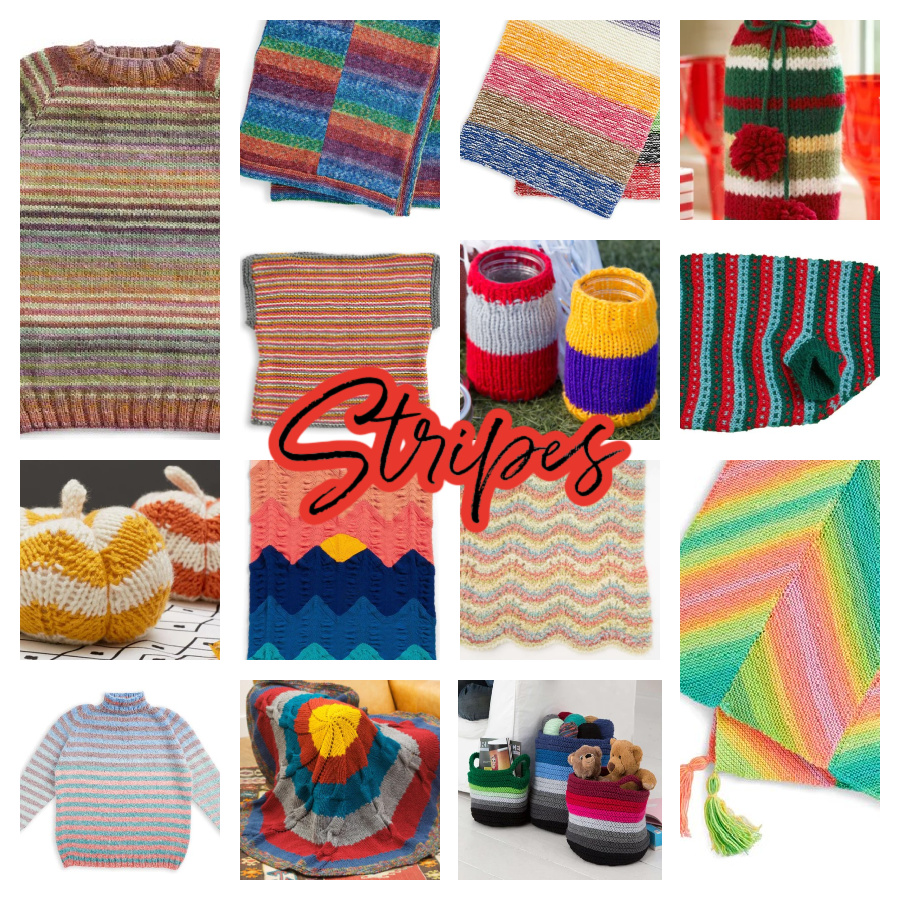
Stripes are by far the simplest knit colorwork technique out there. It’s simply a matter of choosing colors you like, and off you go. Here’s a few stripe patterns to get you going.
Big Stripes Beginner Knit Blanket
Rainbow Connection Knit Panel Blanket
Intarsia Knitting Patterns – Changing Colors Within A Row
Intarsia knitting involves blocks of color. These patterns are usually charted and pretty simple to follow. The difficulty with these projects is when you’re working them flat and must remember which direction you’re reading the pattern. Once you get used to it, you’ll be fine.
The trick to not leaving holes in knit intarsia is to twist the yarns together as you change colors. Here’s a fantastic tutorial about knitting flat intarsia. Check it out, and you can tackle any one of these amazing patterns.
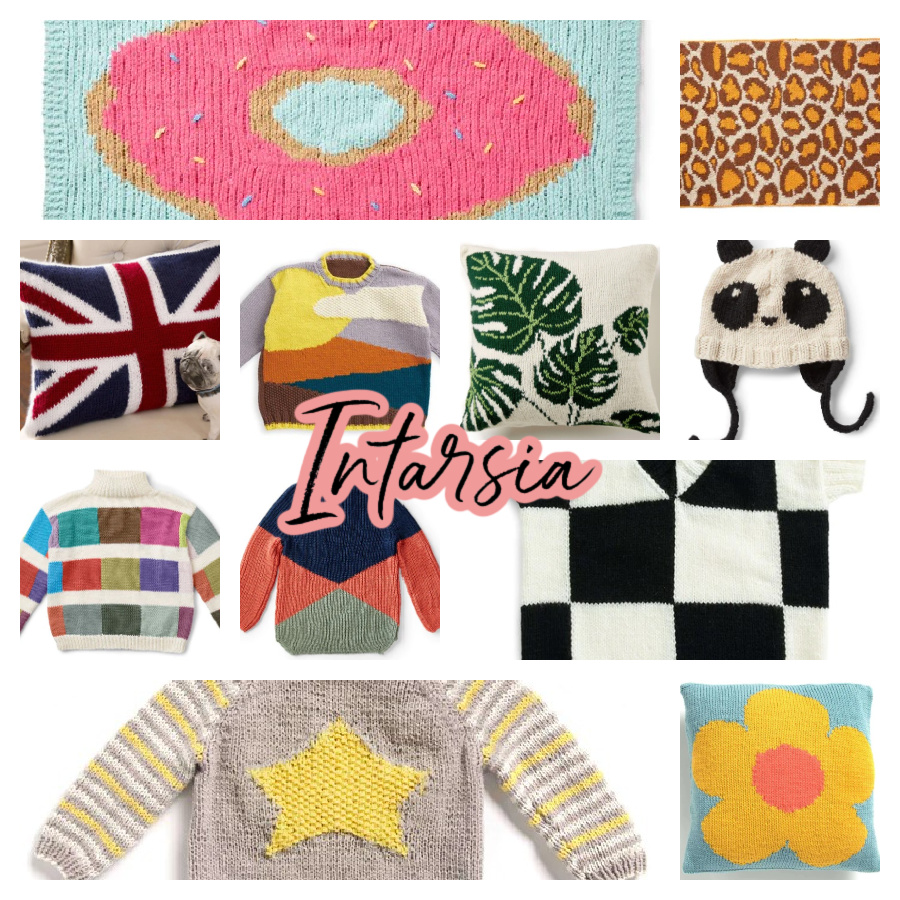
Pantone Monochrome Swatch Knit Sweater
Stranded Colorwork Knitting Patterns
This is where your knitting gets a bit more complex because you’re changing colors several times within each row. But we have all kinds of choices for you, from scarves to sweaters and some stuff in between.
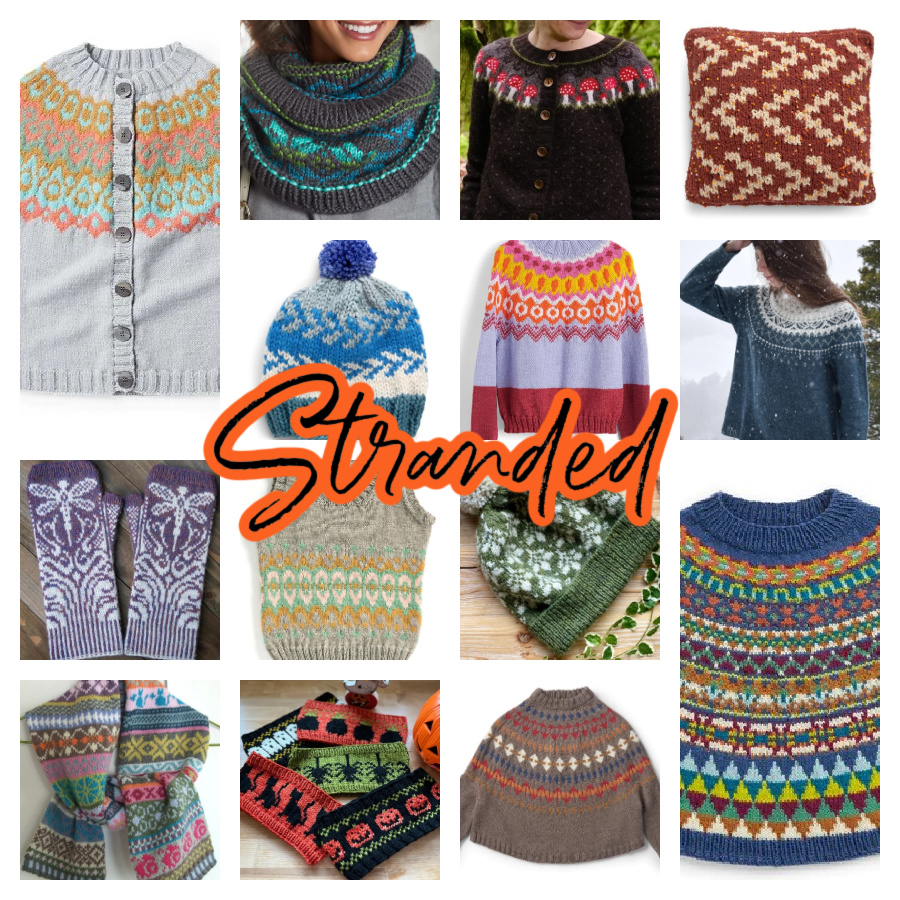
Color Kaleidoscope Poncho If you haven’t already, YOU MUST SEE THIS!!! KAL right now!
Stranded Steeked Knit Cardigan
Knit Colorwork – Mosaic Knitting Patterns
Mosaic knitting is a technique where you only use one color per row, but you use slipped stitches to get the patterning. It’s not as hard as it sounds. Check it out! It produces some fabulous looks!
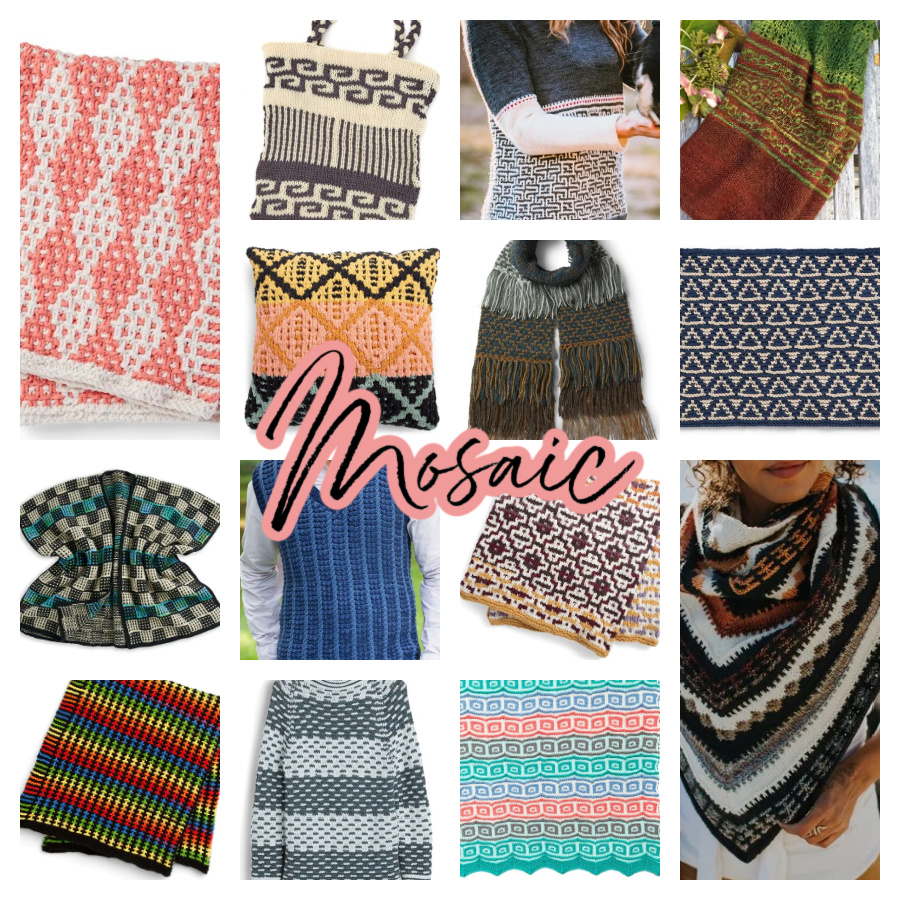
Mosaic Stitch Knit Baby Blanket
Shifting Shades Mosaic Knit Blanket
2-Color Knit Brioche Patterns
Brioche is one of my favorite techniques. It’s so squishy and extra cozy since you have two colors in a rib pattern.
So, instead of regular horizontal stripes, your stripes are columns of vertical stitches. Fantastic!! It’s fascinating how this works, but don’t think too hard about it; just give it a try and add this technique to your arsenal.
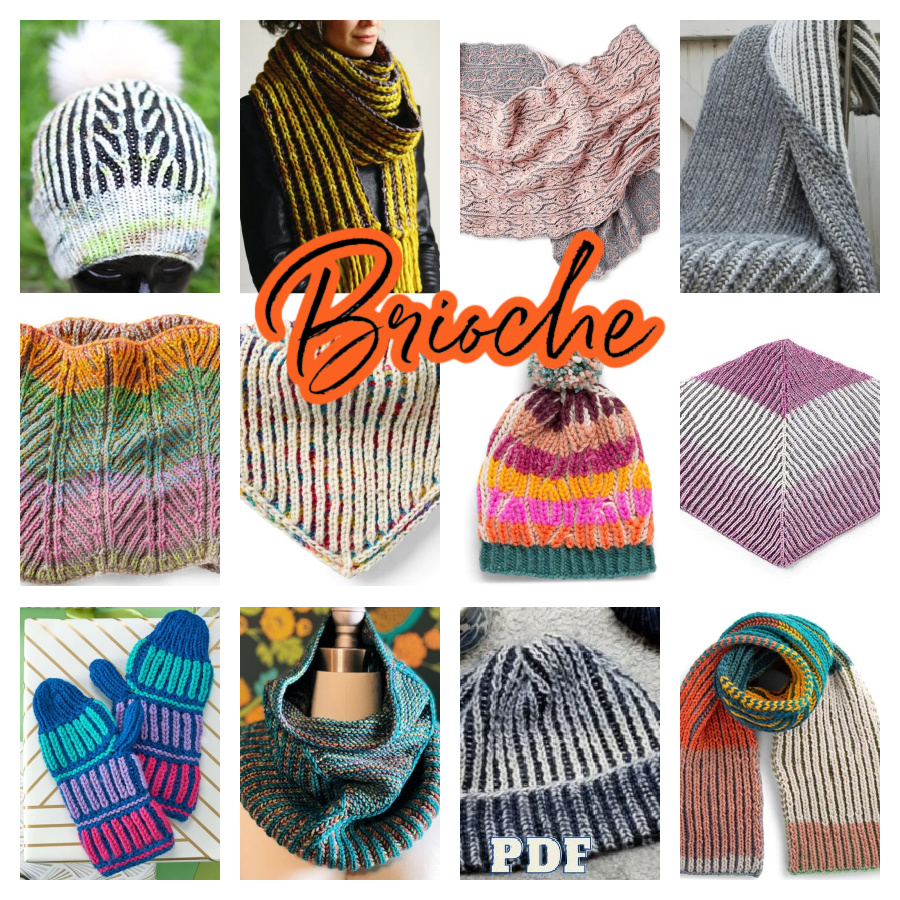
Allan Gardens Knit Brioche Shawl
Double-Sided Brioche Knit Kerchief
I know you’ll have found something here that piques your interest!
And don’t forget…whether you want to try knitting some charming colorwork socks or something much larger, there’s no need to be intimidated when you can learn all about it at Camp Colorwork! Whether you use your fingers and thumbs or a little color separator tool, the keys to knit colorwork are at your fingertips from Continental knitting alone or a combination knitting style!

Camp Colorwork is open all year round!
All the lessons are yours FOR LIFE!
Here’s a few more options that may interest you:
Slipped Stitches Striped Scarf
Crazy Stripes Shawl – LOVE THIS ONE!!!
Categories: Designer Premium Patterns, Free Patterns, Knitting, Round Ups









